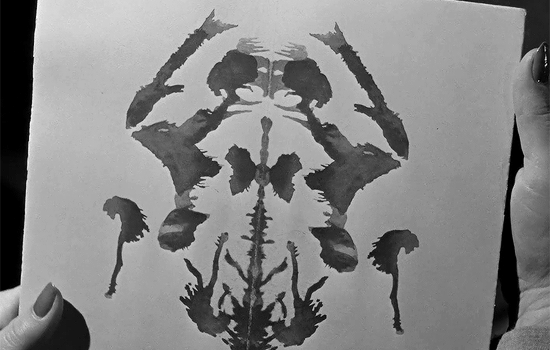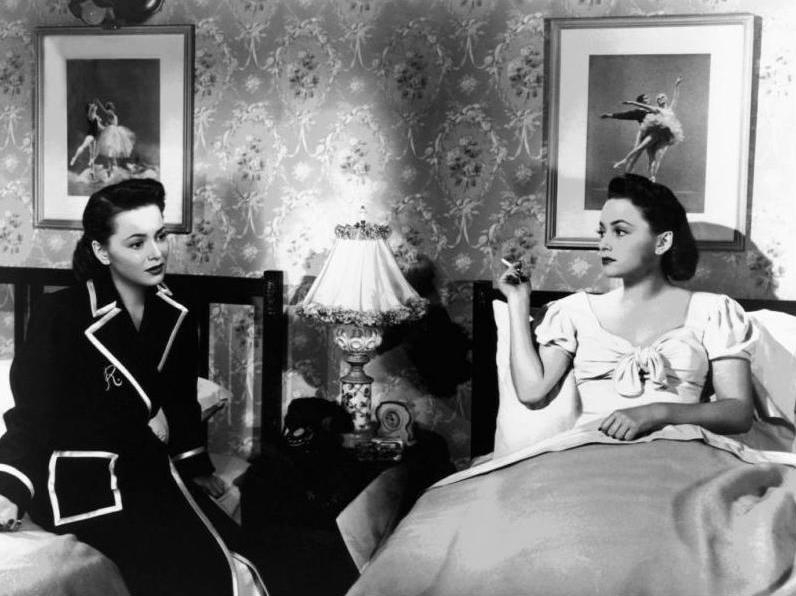Se você gosta de um bom drama, seja em filmes,
livros, novelas ou outra mídia, já deve ter encontrado pela frente o clichê da
gêmea boa e da gêmea má. Essa fórmula de duas pessoas iguais fisicamente, mas com
personalidades diferentes, de modo que uma delas odeia a outra, já foi usada
dos mais diversos jeitos, em atrações interessantes ou como um grande atentado
à inteligência humana. O truque pode ser conhecido hoje, mas era relativamente
novo em 1946. Era a época de filmes noir, dos assassinatos em preto e branco,
das femme fatales. Mas e quando não é
uma, mas duas femme fatales, uma
delas vítima e quiçá cúmplice da outra?
If you
like a good melodrama, in film, books, soap operas or any other media, you might
have met with the good twin / bad twin cliché. The formula of two people
physically identical, but with different, clashing personalities, was already
used in many ways, in interesting works of art or as a poor last resource. The
trick can be well-known today, but it was relatively new in 1946. Tey were the
times of film noir, black and white murders and femme fatales. But what happens
when we have not one, but two femme fatales, and one of them is a victim and
maybe the accomplice of the other one?
O Doutor Peralta foi encontrado morto.
Esfaqueado, assassinado. Dois de seus vizinhos e a secretária apontam como
assassina Teresa Collins (Olivia de Havilland), a moça que vende revistas e com
quem o doutor planejava se casar. De sorriso amplo e olhos brilhantes, Teresa
fica surpresa ao saber da morte do doutor. E mais: tem três álibis que a viram
muito longe do local do crime naquela noite.
Doctor
Peralta was found dead. He was stabbed, he was murdered. Two of his nwighbors
and his secretary believe the killer is Teresa Collins (Olivia de Havilland), a
magazine seller with whom the doctor wanted to get married. With a big smile
and bright eyes, Teresa is shocked to learn about the doctor’s death. And more:
there are three people who can prove she was very far from the place the crime
happened that night.
Mas o caso é mais complicado do que parece:
Teresa tem uma irmã gêmea idêntica, Ruth, e ambas se revezavam na banca de
revistas, de modo que ninguém no edifício sabia que se tratavam de duas irmãs.
Isso frustra o tenente Stevenson (Thomas Mitchell) e o jovem Rusty (Richard
Long), que estava apaixonado pela moça. As irmãs se recusam a falar qualquer
coisa, de modo que fica impossível provar qual é culpada e qual é inocente.
But the
case is more complicated than it looks like: Teresa has an identical twin
sister, Ruth, and both worked at the magazine shop, and nobody at the building
knew there were two sisters running the shop. This frustrates Lieutenant
Stevenson (Thomas Mitchell) and young Rusty (Richard Long), who was in love
with the girl. The sisters refuse to say anything, and it becomes impossible to
prove who is guilty and who is innocent.
Ainda há uma esperança: o doutor Scott Elliott
(Lew Ayres), médico no mesmo edifício e, conveniente e coincidentemente,
especialista em gêmeos. Elas aceitam participar de uma pesquisa com o doutor, e
logo a situação fica óbvia demais: a gêmea má se volta contra a gêmea boa e
tenta fazê-la passar por louca.
There
is still hope: Doctor Scott Elliott (Lew Ayres), a physician at the same
building is, conveniently, an expert in twins. The girls accept to take part in
a research with the doctor, and soon the situation becomes too obvious: the bad
twin turns against the good twin and tries to make people believe the good twin
is crazy.
É um pouco óbvio para o espectador quem é a gêmea
boa e quem é a má. Isso é o ponto frustrante do filme. Entretanto, é
interessante notar como de fato a polícia estava de mãos atadas com este caso.
Com a tecnologia de hoje, provavelmente seria muito mais fácil identificar a
gêmea criminosa. Mas não se preocupe: apesar desta fraqueza, o filme tem bons
momentos e um excelente clímax, capaz de deixar qualquer um boquiaberto e com
os neurônios retorcidos.
It is a
little obvious for the audience who is the the good twin and who is the bad
twin. This is the most frustrating thing in the film. However, it’s interesting
to see how the police was really clueless with the case. With today’s
technology, it’d probably be much easier to find out who is the guilty twin.
But don’t worry: disconsidering this low point, the film has good moments and
an excellent climax, that lets anyone breathless and with confused neurons.
Há um pouco de didatismo no filme. A psique
humana ainda era um enigma para a maioria das pessoas. O pai da psicanálise,
Sigmund Freud, havia morrido fazia apenas sete anos, e o público precisava ser
doutrinado. Mas não se preocupe: não é o estilo “palestra do subconsciente” que
Ingrid Bergman, Gregory Peck e Alfred Hitchcock fizeram um ano antes, em “Quando
Fala o Coração” (1945). A novidade psicológica do filme fica por conta do teste
Rorschach, em que o paciente diz o que vê em uma folha com um borrão de tinta.
Este teste, motivo de piada em diversos filmes e seriados desde então, foi
considerado ineficaz por estudiosos em 1965.
There
is a little didaticism in the film. Human psique was still an enigma for most
people. The father of psychoalysis, Sigmund Freud, had died seven years before,
and the audience needed to be doctrinated. But don’t worry: this is not the
kind of “lecture about the subconscious” that Ingrid Bergman, Gregory Peck and
Alfred Hitchcock did one year before, in “Spellbound” (1945). The big
psychological novelty in the film is the Rorschach test, in which the patient
describes what he or she sees in a paper with a paint stain. This test, center
of many jokes in movies and series since then, was considered ineffective by
academics in 1965.
É curioso ver o diálogo sobre rivalidade entre
irmãs ser feito justamente para Olivia de Havilland, que teve uma longa rixa
com a irmã também atriz Joan Fontaine. Os detalhes dessa rivalidade que vem
desde a infância não foram tornados públicos (ao menos não todos os detalhes),
mas sem dúvida é impossível dizer quem estava certa ou errada na disputa De
Havilland contra Fontaine.
It is
curious to see the dialog about sibling rivalry being acted exactly by Olivia
de Havilland, who had a long feud with her sister (and also actress) Joan
Fontaine. The details of this rivalry that comes since childhood were never
made public (at least not ALL details), but without a doubt it’s impossible to
say who was right or wrong in the De Havilland against Fontaine case.
Para Olivia de Havilland, 1946 foi um grande ano.
Ela ficou dois anos afastada do cinema enquanto lutava para se livrar do
abusivo contrato de sete anos da Warner Brothers. Por ter rejeitado vários
papéis ruins, Olivia foi informada de que ficaria mais seis meses exclusiva da
Warner, como forma de punição. Ela foi aos tribunais e ganhou o caso, mas,
graças à influência da Warner em Hollywood, nenhum estúdio lhe ofereceu
trabalho entre 1944 e 1946. Lew Ayres também estava afastado do cinema, porque
deixou Hollywood em 1942 para trabalhar como médico e capelão durante a guerra
no Pacífico. Protagonista de “Sem Novidade no Front” (1930), Ayres era um
grande pacifista e perdeu a simpatia dos colegas durante a guerra porque se
opunha ao conflito.
For
Olivia de Havilland, 1946 was a fantastic year. She was far from movies for two
years, fighting to get rido f Warner Brothers’s abusive seven-year contract.
Because she rejected several bad roles, Olivia was informed that she would be a
Warner exclusive for six more months as a punishment. She went to court and won
the case, but, thanks to Warner’s influence in Hollywood, no studio offered her
work between 1944 and 1946. Lew Ayres was also far from the movie business,
because he left Hollywood in 1942 to work as doctor and chaplain during the war
in the Pacific. The lead of “All Quiet on the Western Front” (1946), Ayres was
a pacifist and lost the sympathy of his movie colleagues because he was against
the war.
Este não é o melhor filme de nenhum de seus
atores. Não é o melhor filme do diretor Robert Siodmak (de “Os Assassinos”,
1946) nem do produtor Nunnally Johnson (de “Um Retrato de Mulher”, 1944). Mas é
um filme muito bom, como o são todos os clássicos.
This is
not the best film for nwither Olivia now Lew. It is not the best film by
director Robert Siodmack (who did “The Killers” also in 1946) nor by producer
Nunnally Johnson (from “The Woman in the Window”, 1944). But it is a very good classic film nonetheless.







8 comments:
ah, não vi. anotadíssimo. beijos, pedrita
Hallo fellow Dueling Diva participant!
I had never heard of this film before, and I have to say it looks like great fun. Secret evil twins and a murder investigation - it sounds like my kind of drama! I have always rather liked Olivia de Havilland, too. Thanks for the write-up :)
Le, here is another movie you've introduced me to. I've heard of it, but haven't had the chance to see it. It would be fascinating to see Olivia in the dual role because of the falling-out with her sister, as you've pointed out. This is a great Duelling Divas choice!
I've never thought about how much her real-life sibling rivalry must have informed her in characterizing these twins. Such an interesting post.
I love how Siodomak went to great, if not very subtle, lengths to keep the audience informed about which twin is which - from monogrammed dressing gowns to initialed brooches, compact mirrors and oversize name necklaces. That kind of undermines the power of the film for me! Also, the more I watch it the more the ending confuses me - it’s impossible not to be convinced that perhaps Ruth and Terry have changed roles; that the two are so adept, and indeed used to, swapping between or playing a role that even they aren’t sure who is who anymore.
what could be more fun that 2 Olivias? Maybe if sister Joan played the other part - how delicious would that be? You're right - not the best work of all involved, but fun nonetheless.
falei de um filme clássico no meu blog. beijos, pedrita
This looks interesting. I especially want to see how they portray the inkblot test on screen. (Psychology on film fascinates me.)
Post a Comment